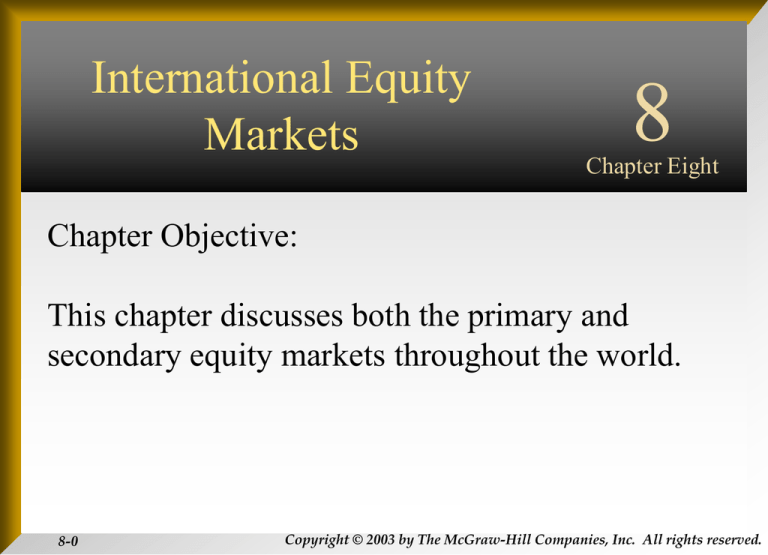
International Equity
Markets
Chapter Objective:
8
Chapter Eight
INTERNATIONAL
FINANCIAL
MANAGEMENT
This chapter discusses both the primary and
secondary equity markets throughout the world.
Third Edition
EUN / RESNICK
8-0
Copyright © 2003 by The McGraw-Hill Companies, Inc. All rights reserved.
Chapter Outline
A Statistical Perspective
Market Structure, Trading Practices, and Costs
International Equity Market Benchmarks
World Equity Market Benchmark Shares
Trading in International Equities
Factors Affecting International Equity Returns
8-1
Copyright © 2003 by The McGraw-Hill Companies, Inc. All rights reserved.
Chapter Outline
A Statistical Perspective
Market Capitalization of Developed Countries
Market Capitalization of Developing Countries
Measures of Liquidity
Measures of Market Concentration
Market Structure, Trading Practices, and Costs
International Equity Market Benchmarks
World Equity Market Benchmark Shares
Trading in International Equities
Factors Affecting International Equity Returns
8-2
Copyright © 2003 by The McGraw-Hill Companies, Inc. All rights reserved.
Chapter Outline
A Statistical Perspective
Market Structure, Trading Practices, and Costs
International Equity Market Benchmarks
World Equity Market Benchmark Shares
Trading in International Equities
Factors Affecting International Equity Returns
8-3
Copyright © 2003 by The McGraw-Hill Companies, Inc. All rights reserved.
Chapter Outline
A Statistical Perspective
Market Structure, Trading Practices, and Costs
International Equity Market Benchmarks
World Equity Market Benchmark Shares
Trading in International Equities
Factors Affecting International Equity Returns
8-4
Copyright © 2003 by The McGraw-Hill Companies, Inc. All rights reserved.
Chapter Outline
A Statistical Perspective
Market Structure, Trading Practices, and Costs
International Equity Market Benchmarks
World Equity Market Benchmark Shares
Trading in International Equities
Factors Affecting International Equity Returns
8-5
Copyright © 2003 by The McGraw-Hill Companies, Inc. All rights reserved.
Chapter Outline
A Statistical Perspective
Market Structure, Trading Practices, and Costs
International Equity Market Benchmarks
World Equity Market Benchmark Shares
Trading in International Equities
Magnitude of International Equity Trading
Cross-Listing of Shares
Yankee Stock Offerings
The European Stock Market
American Depository Receipts
Factors Affecting International Equity Returns
8-6
Copyright © 2003 by The McGraw-Hill Companies, Inc. All rights reserved.
Chapter Outline
A Statistical Perspective
Market Structure, Trading Practices, and Costs
International Equity Market Benchmarks
World Equity Market Benchmark Shares
Trading in International Equities
Factors Affecting International Equity Returns
8-7
Copyright © 2003 by The McGraw-Hill Companies, Inc. All rights reserved.
A Statistical Perspective
Market Capitalization of Developed Countries
Market Capitalization of Developing Countries
Measures of Liquidity
Measures of Market Concentration
8-8
Copyright © 2003 by The McGraw-Hill Companies, Inc. All rights reserved.
Market Capitalization of Developed
Countries
Almost 92% of the total market capitalization of
the world’s equity markets is accounted for by the
market capitalization of the developed world.
8-9
Copyright © 2003 by The McGraw-Hill Companies, Inc. All rights reserved.
Market Capitalization of
Developing Countries
The other 10% is accounted for by the market
capitalization of developing countries in
“emerging markets”.
Latin America
Asia
Eastern Europe
Mideast/Africa
Recently the growth rates in these emerging
markets have been strong, but with more volatility
than we have here at home.
8-10
Copyright © 2003 by The McGraw-Hill Companies, Inc. All rights reserved.
Measures of Liquidity
The equity markets of the developed world tend to
be much more liquid than emerging markets.
Liquidity refers to how quickly an asset can be sold
without a major price concession.
So, while investments in emerging markets may
be profitable, the focus should be on the long
term.
8-11
Copyright © 2003 by The McGraw-Hill Companies, Inc. All rights reserved.
Measures of Market Concentration
Emerging Markets tend to be much more
concentrated than our markets.
Concentrated in relatively few companies.
That is, a few issues account for a much larger
percentage of the overall market capitalization in
emerging markets than in the equity markets of
the developed world.
8-12
Copyright © 2003 by The McGraw-Hill Companies, Inc. All rights reserved.
Market Structure,
Trading Practices, and Costs
Primary Markets
Shares offered for sale directly from the issuing
company.
Secondary Markets
8-13
Provide market participants with marketability and
share valuation.
Copyright © 2003 by The McGraw-Hill Companies, Inc. All rights reserved.
Market Structure,
Trading Practices, and Costs
Market Order
Limit Order
An order to your broker to buy or sell share
immediately at the market price.
An order to your broker to buy or sell at the at a price
you want, when and if he can.
If immediate execution is more important than the
price, use a market order.
8-14
Copyright © 2003 by The McGraw-Hill Companies, Inc. All rights reserved.
Market Structure,
Trading Practices, and Costs
Dealer Market
Auction Market
The stock is sold by dealers, who stand ready to buy
and sell the security for their own account.
In the U.S., the OTC market is a dealer market.
Organized exchanges have specialists who match buy
and sell orders. Buy and sell orders may get matched
without the specialist buying and selling as a dealer.
Automated Exchanges
8-15
Computers match buy and sell orders.
Copyright © 2003 by The McGraw-Hill Companies, Inc. All rights reserved.
International Equity Market
Benchmarks
North America
Europe
Asia/Pacific Rim
8-16
Copyright © 2003 by The McGraw-Hill Companies, Inc. All rights reserved.
North American Equity Market
Benchmarks
Name
Symbol
DJIA
Dow Jones Industrial Average
NASDAQ Combined
Composite
S&P 500
CCMP
TSE 300
TS300
Mexico BOLSA Index
8-17
SPX
MEXBOL
Copyright © 2003 by The McGraw-Hill Companies, Inc. All rights reserved.
European Equity Market Benchmarks
8-18
Name
Symbol
FT-SE 100
UKX
CAC 40
CAC
Frankfurt DAX Index
DAX
IBEX Index
IBEX
Milan MIB30
MIB30
BEL20 Index
BEL20
Copyright © 2003 by The McGraw-Hill Companies, Inc. All rights reserved.
Asia/ Pacific Rim Equity Market
Benchmarks
Symbol
Name
8-19
NIKKEI 225 Index
NKY
Hang Seng Index
HSI
Sing Straits Times Index
STI
ASX All Ordinaries Index
AS300
Copyright © 2003 by The McGraw-Hill Companies, Inc. All rights reserved.
World Equity Benchmark Shares
World Equity Benchmark Shares (WEBS)
8-20
Country-specific baskets of stocks designed to replicate
the country indexes of 14 countries.
WEBS are subject to U.S. SEC and IRS diversification
requirements.
Low cost, convenient way for investors to hold
diversified investments in several different countries.
Copyright © 2003 by The McGraw-Hill Companies, Inc. All rights reserved.
Trading in International Equities
Magnitude of International Equity Trading
Cross-Listing of Shares
Yankee Stock Offerings
The European Stock Market
American Depository Receipts
8-21
Copyright © 2003 by The McGraw-Hill Companies, Inc. All rights reserved.
Magnitude of International
Equity Trading
During the 1980s world capital markets began a
trend toward greater global integration.
Diversification, reduced regulation, improvements
in computer and communications technology,
increased demand from MNCs for global
issuance.
8-22
Copyright © 2003 by The McGraw-Hill Companies, Inc. All rights reserved.
Cross-Listing of Shares
Cross-Listing refers to a firm having its equity
shares listed on one or more foreign exchanges.
The number of firms doing this has exploded in
recent years.
8-23
Copyright © 2003 by The McGraw-Hill Companies, Inc. All rights reserved.
Advantages of Cross-Listing
It expands the investor base for a firm.
Establishes name recognition for the firm in new
capital markets, paving the way for new issues.
May offer marketing advantages.
May mitigate possibility of hostile takeovers.
8-24
Copyright © 2003 by The McGraw-Hill Companies, Inc. All rights reserved.
Yankee Stock Offerings
The direct sale of new equity capital to U.S.
public investors by foreign firms.
8-25
Privatization in South America and Eastern Europe
Equity sales by Mexican firms trying to cash in on
NAFTA
Copyright © 2003 by The McGraw-Hill Companies, Inc. All rights reserved.
The European Stock Market
There is not as yet a single European stock market
that comprises all national markets.
NASDAQ Europe hopes to become a panEuropean stock market that operates
independently of any national European exchange.
All trading is denominated in the euro.
It expects to offer trading in both European and
U.S. stocks.
www.NasdaqEurope.com
8-26
Copyright © 2003 by The McGraw-Hill Companies, Inc. All rights reserved.
American Depository Receipts
Foreign stocks often trade on U.S. exchanges as
ADRs.
It is a receipt that represents the number of foreign
shares that are deposited at a U.S. bank.
The bank serves as a transfer agent for the ADRs
8-27
Copyright © 2003 by The McGraw-Hill Companies, Inc. All rights reserved.
American Depository Receipts
There are many advantages to trading ADRs as
opposed to direct investment in the company’s
shares:
8-28
ADRs are denominated in U.S. dollars, trade on U.S.
exchanges and can be bought through any broker.
Dividends are paid in U.S. dollars.
Most underlying stocks are bearer securities, the ADRs
are registered.
Copyright © 2003 by The McGraw-Hill Companies, Inc. All rights reserved.
Global Registered Shares
DaimlerChrysler AG is a German firm, whose
stock trades as a GRS.
GRS are one share traded globally, unlike ADRs,
which are receipts for banks deposits of homemarket shares and traded on foreign markets.
They trade in both dollars and euros.
All shareholders have equal status and voting
rights.
8-29
Copyright © 2003 by The McGraw-Hill Companies, Inc. All rights reserved.
Factors Affecting
International Equity Returns
Macroeconomic Factors
Exchange Rates
Industrial Structure
8-30
Copyright © 2003 by The McGraw-Hill Companies, Inc. All rights reserved.
Macroeconomic Factors Affecting
International Equity Returns
The data do not support the notion that equity
returns are strongly influenced by macro factors.
That is correspondent with findings for U.S.
equity markets.
8-31
Copyright © 2003 by The McGraw-Hill Companies, Inc. All rights reserved.
Exchange Rates
Exchange rate movements in a given country
appear to reinforce the stock market movements
within that country.
One should be careful not to confuse correlation
with causality.
8-32
Copyright © 2003 by The McGraw-Hill Companies, Inc. All rights reserved.
Industrial Structure
Studies examining the influence of industrial
structure on foreign equity returns are
inconclusive.
8-33
Copyright © 2003 by The McGraw-Hill Companies, Inc. All rights reserved.
End Chapter Eight
8-34
Copyright © 2003 by The McGraw-Hill Companies, Inc. All rights reserved.






